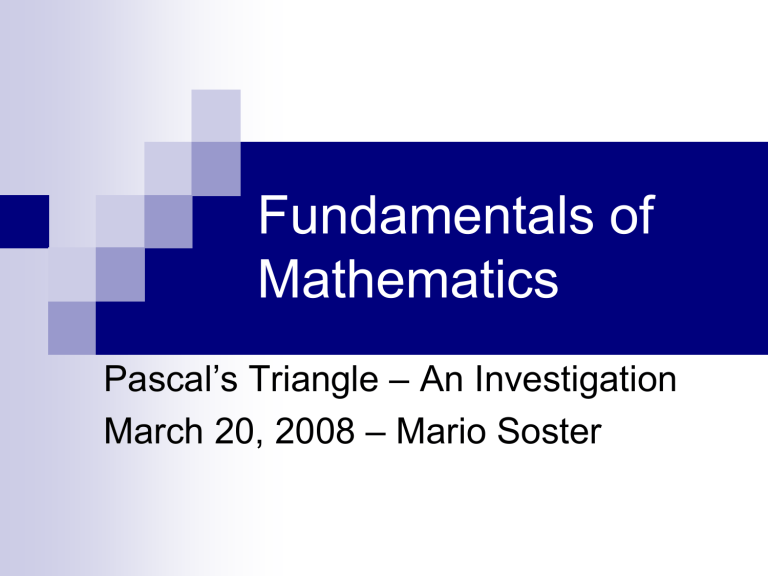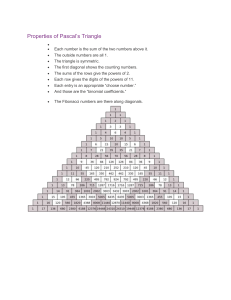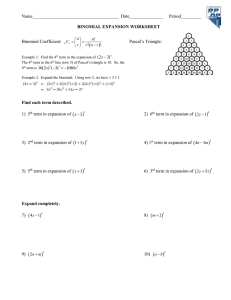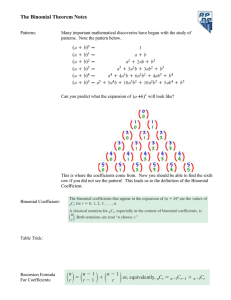
Fundamentals of Mathematics Pascal’s Triangle – An Investigation March 20, 2008 – Mario Soster Historical Timeline A triangle showing the binomial coefficients appear in an Indian book in the 10th century In the 13th century Chinese mathematician Yang Hui presents the arithmetic triangle In the 16th century Italian mathematician Niccolo Tartaglia presents the arithmetic triangle Yang Hui’s Triangle Historical Timeline cont… Blasé Pascal 1623-1662, a French Mathematician who published his first paper on conics at age 16, wrote a treatise on the ‘arithmetical triangle’ which was named after him in the 18th century (still known as Yang Hui’s triangle in China) Known as a geometric arrangement that displays the binomial coefficients in a triangle Pascal’s Triangle 1 What is the pattern? 1 1 1 2 1 1 3 3 1 What is the next row going to be? 1 4 6 4 1 1 5 10 10 5 1 We are taking the sum of the two numbers directly above it. How does this relate to combinations? Using your calculator find the value of: 5 0 5 1 5 2 5 3 5 4 5 5 1 5 10 10 5 1 • What pattern do we notice? It follow’s Pascal’s Triangle So, Pascal’s Triangle is: r=0 0 0 n=0 1 0 n=1 2 0 n=2 n=3 3 0 r=1 1 1 2 1 3 1 r=2 2 2 3 2 r=3 3 3 Pascal’s Identity/Rule “The sum of the previous two terms in the row above will give us the term below.” n n n 1 r r 1 r 1 Example 1: a) How do you simplify b) How do you write 12 3 11 11 4 5 into a single expression? as an expanded expression? a) Use Pascal’s Identity: n n n 1 r r 1 r 1 11 11 n = 11, and r = 4 4 5 11 1 4 1 12 5 b) Use Pascal’s Identity: n n n 1 r r 1 r 1 12 3 n + 1 = 12, and r + 1 = 3, so n = 11 and r = 2 11 11 2 3 Or, what is 12 – 3? If you said 9 … try in your calculator: 12 3 12 9 They are the same thing! Therefore C(n,r) is equivalent to C(n,n-r) Example 2: A former math student likes to play checkers a lot. How many ways can the piece shown move down to the bottom? Use Pascal’s Triangle: 1 1 1 1 1 1 1 2 3 4 5 6 1 2 5 9 14 5 14 Example 3: How many different paths can be followed to spell the word ‘Fundamentals’? F U N D A M E D M N N A E D M N A E T N A E N T A L S M E T L S M N A A E T L D M N A N A E T U Use Pascal’s Triangle: 1 11 121 1331 14641 1 5 10 10 5 1 1 6 15 20 15 6 1 7 21 35 35 21 7 28 56 70 56 28 84 126 126 84 210 252 210 462 462 Therefore there are (462 + 462) = 924 total ways. Using combinations, since there are 12 rows and the final value is in a central position then there C(12,6) = 924 total ways. Example 3: The GO Train Station is 3 blocks south and 4 blocks east of a student’s house. How many different ways can the student get to the Go Train Station? The student can only go south or east. Draw a map: Student’s House 1 1 1 1 1 2 3 4 5 1 3 6 10 15 1 4 10 20 35 Go Train Station Therefore there are 35 different ways of going from the student’s house to the GO Train station. Note: Using combinations: C((# of rows + # of columns), (# of rows)) C(7,4) = 35 Try This: Expand (a+b)4 a 4 4a 3b 6a 2b 2 4ab3 b 4 Binomial Theorem The coefficients of this expansion results in Pascal’s Triangle n n n n 1 n n2 2 n nr r n n (a b) a a b a b ... a b ... b 0 1 2 r n n The coefficients of the form called binomial coefficients n r are Example 4: Expand (a+b)4 Use the Binomial Theorem: 4 4 4 3 4 2 2 4 3 4 4 (a b) a a b a b ab b 0 1 2 3 4 a 4 4a 3b 6a 2b 2 4ab3 b 4 4 What patterns do we notice? • Sum of the exponents in each section will always equal the degree of the original binomial • The “r” value in the combination is the same as the exponent for the “b” term. Example 5: Expand (2x – 1)4 Use the Binomial Theorem: 4 4 4 4 4 4 3 2 2 3 (2 x 1) (2 x) (2 x) (1) (2 x) (1) (2 x)( 1) (1) 4 0 1 2 3 4 24 x 4 (4)(23 x3 )(1) 6(22 x 2 )( 1) 2 4(2 x)(1)3 (1) 4 4 16 x 4 (4)(8x3 )(1) (6)(4 x 2 )(1) (4)( 2 x)(1) (1) 16 x 4 32 x 3 24 x 2 8 x 1 Example 6: Express the following in the form (x+y)n 5 5 5 4 5 5 5 5 a a b a 3b 2 a 2b 3 ab 4 b 5 0 1 2 3 4 5 Check to see if the expression is a binomial expansion: 5 5 5 4 5 3 2 5 2 3 5 4 5 5 a a b a b a b ab b 0 1 2 3 4 5 • The sum of the exponents for each term is constant • The exponent of the first variable is decreasing as the exponent of the second variable is increasing n= 5 So the simplified expression is: (a + b)5 General Term of a Binomial Expansion The general term in the expansion of (a+b)n is: n nr r tr 1 a b r where r =0, 1, 2, … n Example 7: What is the 5th term of the binomial expansion of (a+b)12? Apply the general term formula! n = 12 r= 4 (a+b)12 5th term wanted (r +1) = 5 n nr r tr 1 a b r 12 124 4 t 41 a b 4 t5 495a 8b 4 Other Patterns or uses: Fibonacci Numbers (found using the ‘shadow diagonals’) Figurate Numbers Mersenne Number Lucas Numbers Catalan Numbers Bernoulli Numbers Triangular Numbers Tetrahedral Numbers Pentatope Numbers Sources: Grade 12 Data Management Textbooks http://en.wikipedia.org/wiki/Pascal%27s_triangle http://www.math.wichita.edu/history/topics/notheory.html#pascal http://mathforum.org/workshops/usi/pascal/pascal.links.html http://mathworld.wolfram.com/PascalsTriangle.html http://milan.milanovic.org/math/ (check out this website, select English) or use http://milan.milanovic.org/math/english/contents.html




